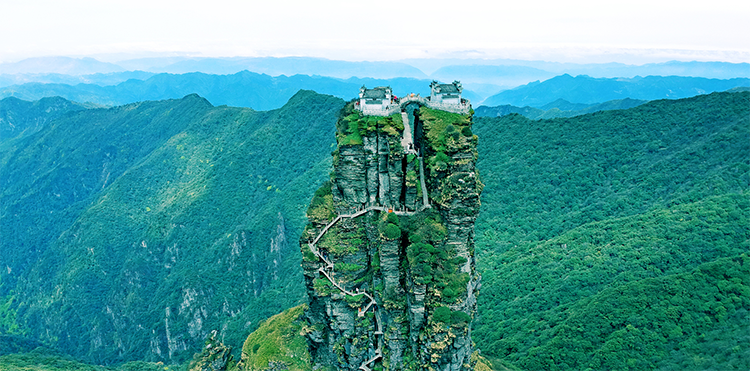Discover Fanjing Mountain — A UNESCO Natural Heritage Site with Sacred Misty Peak & Primal Forest
Fanjing Mountain: Sacred Misty Peak and Primal Forest
Nestled in the misty ranges of northeastern Guizhou, Fanjing Mountain (Fanjingshan) is a UNESCO-protected secret that the organization has praised as an “earth oasis.” Equal parts Buddhist sanctuary and billion-year geological museum, this remote massif reveals red-clouded golden summits, rare wildlife, and an ancient forest that feels suspended in time. When morning fog wraps the Red Cloud Golden Summit and the Guizhou snub-nosed monkeys leap through the dove-tree branches, you understand why this place has long been called a “pure land.”
1. World Natural Heritage’s Dual Soul
Fanjing Mountain’s uniqueness lies in the seamless blend of two extremes: the wildness of primordial ecology and the spiritual depth of Buddhist culture. Inscribed as a UNESCO World Natural Heritage site in 2018, it protects one of the most intact primeval forests at its latitude, home to roughly 800 endangered Guizhou snub-nosed monkeys and the rare dove-tree (Davidia involucrata), often called a living fossil. At 2,572 meters, the Phoenix Peak summit is crowned by Ming-dynasty temples and bizarre rock formations. After rain, when mist swells between the twin peaks known as the Red Cloud Golden Summit, the scene feels like the entrance to a heavenly realm.
2. Witness to a Billion-Year Geological Epic
Fanjing is a stone-written chronicle of deep time. Mushroom-shaped rocks appear like giant umbrellas from another world, while multi-layered shale on the “Ten-Thousand-Scroll Rock” resembles stacked ancient sutras. These formations, shaped over some 1 billion years, record dramatic tectonic collisions. Geologists have identified the rare “Fanjing rotational structure” here, while casual visitors find their imaginations sparked by named stones such as Prince Stone and Eagle Rock. Local Miao legends treat these anthropomorphic rocks as protective spirits of the mountain.

3. A Buddhist Sacred Mountain of Bells and Chants
Since the Ming emperor Wanli ordered the construction of the Huguo Temple, Fanjing has stood alongside Emei and Wutai as a major Buddhist pilgrimage site. The steep iron-chain paths up to the Red Cloud Golden Summit test both body and mind. At the peak, two ancient temples—Shakyamuni Hall and Maitreya Hall—are connected by a narrow single-person stone bridge hovering over a sheer drop and a roiling sea of clouds; the view is a visceral, unforgettable moment. Scattered across the mountain are 24 Ming and Qing dynasty temples; Cheng’en Temple’s Nine-Dragon Wall and stone stele forest still echo with six centuries of chanting and incense.
4. A Natural Theater of Four Seasons
– Spring (March–May): High-altitude rhododendrons bloom from base to summit; dove-trees display their white “dove” flowers like dancing skirts.
– Midsummer (June–August): Pleasant 20°C temperatures, full waterfalls, and firefly-lit nights.
– Golden Autumn (September–November): Forests blaze in color, cloud seas appear with up to 80% probability, and rare optical phenomena such as Buddha’s light are frequent.
– Deep Winter (December–February): Rime and ice create glassy landscapes, though some trails may be closed.
Best time to visit: Autumn (September–October) for comfortable weather, excellent visibility, and vivid colors. For Buddha’s light, aim for a clear morning after rain and reach the summit at sunrise.

5. Practical Travel Guide
Transport:
– From Tongren Fenghuang Airport it’s about a 1.5-hour drive to the scenic east gate (Jiangkou County). You can also take the tourist shuttle bus from Tongren South Station (approx. RMB 50).
– Inside the park you must transfer to an eco-shuttle (around 20 minutes) to the cable car station; then a 30-minute cable car takes you into the core area.
Suggested routes:
– One-day highlights: Cable car up → Mushroom Rock → Red Cloud Golden Summit → Cheng’en Temple (6–8 hours; suitable for fit hikers).
– Two-day deep visit: Add a trek through the primeval forest trails, stargazing at Wanbao Rock, and exploration of the Heibai River waterfall cluster.

Tips:
– Admission generally includes the sightseeing bus (RMB 160); a single cable car ride is about RMB 70 (round-trip recommended).
– Reaching the Red Cloud Golden Summit requires hands-on scrambling with iron chains—wet conditions are slippery and demand caution.
– Temperatures at the summit are often 10°C or more cooler than the valley below; bring a windproof jacket.
When the setting sun gilds the Mushroom Rock and Buddhist chants drift through the dove-trees, it’s clear why generations of practitioners chose Fanjing to seek insight. More than a visual expedition, Fanjing Mountain is a sensory and spiritual dialogue—every stone tells of eternity, every cloud conceals a koan. Bring respect and curiosity: this UNESCO heritage is ready to share secrets shaped over a billion years.


